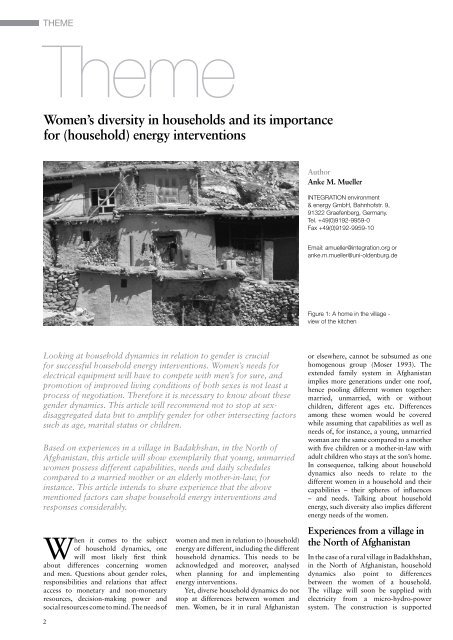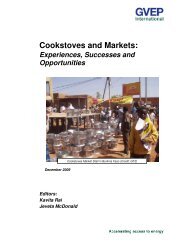Household Dynamics - HEDON Household Energy Network
Household Dynamics - HEDON Household Energy Network
Household Dynamics - HEDON Household Energy Network
You also want an ePaper? Increase the reach of your titles
YUMPU automatically turns print PDFs into web optimized ePapers that Google loves.
THEME<br />
Theme<br />
Women’s diversity in households and its importance<br />
for (household) energy interventions<br />
Looking at household dynamics in relation to gender is crucial<br />
for successful household energy interventions. Women’s needs for<br />
electrical equipment will have to compete with men’s for sure, and<br />
promotion of improved living conditions of both sexes is not least a<br />
process of negotiation. Therefore it is necessary to know about these<br />
gender dynamics. This article will recommend not to stop at sexdisaggregated<br />
data but to amplify gender for other intersecting factors<br />
such as age, marital status or children.<br />
Based on experiences in a village in Badakhshan, in the North of<br />
Afghanistan, this article will show exemplarily that young, unmarried<br />
women possess different capabilities, needs and daily schedules<br />
compared to a married mother or an elderly mother-in-law, for<br />
instance. This article intends to share experience that the above<br />
mentioned factors can shape household energy interventions and<br />
responses considerably.<br />
When it comes to the subject<br />
of household dynamics, one<br />
will most likely first think<br />
about differences concerning women<br />
and men. Questions about gender roles,<br />
responsibilities and relations that affect<br />
access to monetary and non-monetary<br />
resources, decision-making power and<br />
social resources come to mind. The needs of<br />
2<br />
women and men in relation to (household)<br />
energy are different, including the different<br />
household dynamics. This needs to be<br />
acknowledged and moreover, analysed<br />
when planning for and implementing<br />
energy interventions.<br />
Yet, diverse household dynamics do not<br />
stop at differences between women and<br />
men. Women, be it in rural Afghanistan<br />
Author<br />
Anke M. Mueller<br />
iNTeGRATiON environment<br />
& energy GmbH, Bahnhofstr. 9,<br />
91322 Graefenberg, Germany.<br />
Tel. +49(0)9192-9959-0<br />
Fax +49(0)9192-9959-10<br />
email: amueller@integration.org or<br />
anke.m.mueller@uni-oldenburg.de<br />
Figure 1: A home in the village -<br />
view of the kitchen<br />
or elsewhere, cannot be subsumed as one<br />
homogenous group (Moser 1993). The<br />
extended family system in Afghanistan<br />
implies more generations under one roof,<br />
hence pooling different women together:<br />
married, unmarried, with or without<br />
children, different ages etc. Differences<br />
among these women would be covered<br />
while assuming that capabilities as well as<br />
needs of, for instance, a young, unmarried<br />
woman are the same compared to a mother<br />
with five children or a mother-in-law with<br />
adult children who stays at the son’s home.<br />
In consequence, talking about household<br />
dynamics also needs to relate to the<br />
different women in a household and their<br />
capabilities – their spheres of influences<br />
– and needs. Talking about household<br />
energy, such diversity also implies different<br />
energy needs of the women.<br />
Experiences from a village in<br />
the North of Afghanistan<br />
In the case of a rural village in Badakhshan,<br />
in the North of Afghanistan, household<br />
dynamics also point to differences<br />
between the women of a household.<br />
The village will soon be supplied with<br />
electricity from a micro-hydro-power<br />
system. The construction is supported





